CADILLAC SEVILLE 1998 4.G Owners Manual
Manufacturer: CADILLAC, Model Year: 1998, Model line: SEVILLE, Model: CADILLAC SEVILLE 1998 4.GPages: 378, PDF Size: 21.99 MB
Page 91 of 378
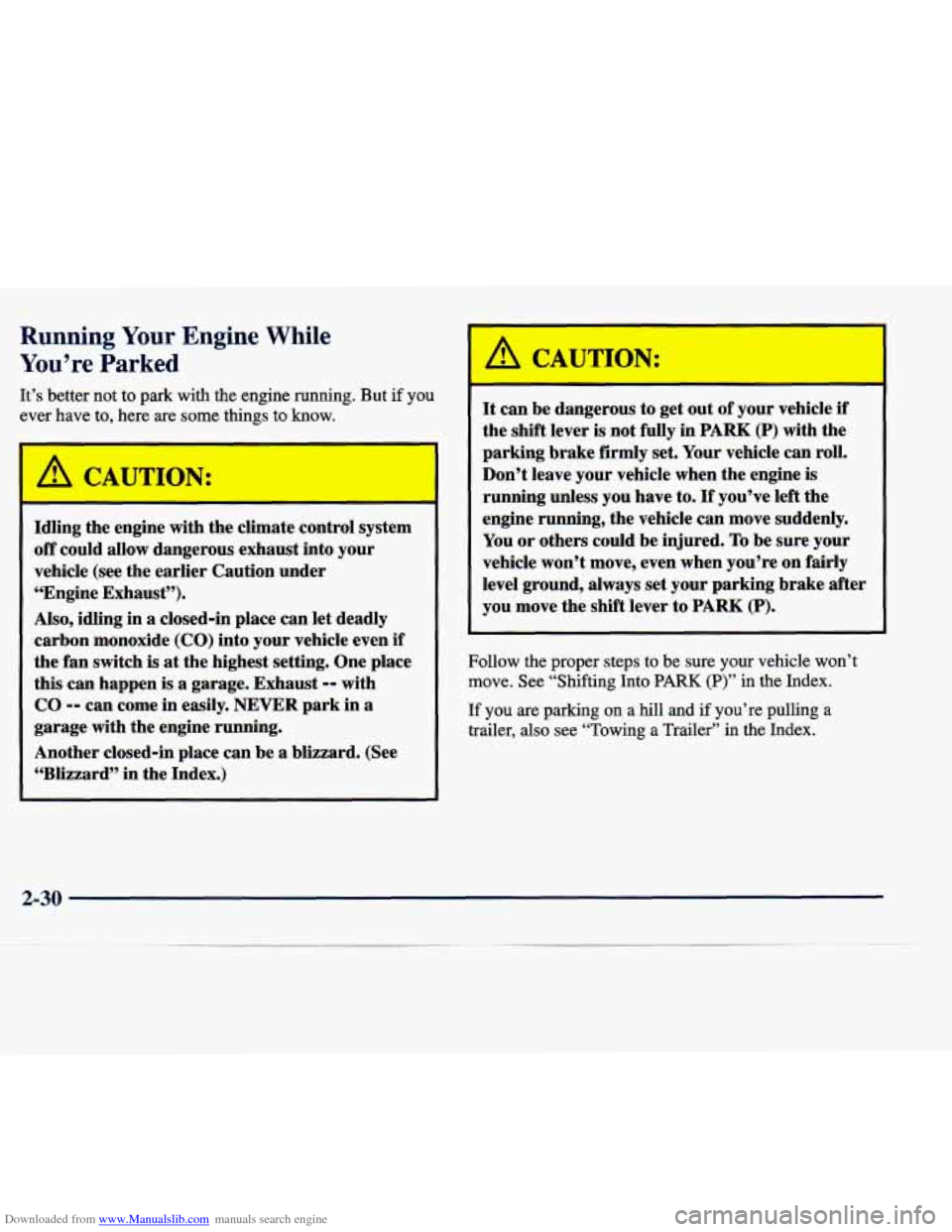
Downloaded from www.Manualslib.com manuals search engine Running Your Engine While
You’re Parked
Idling the engine with the climate control system
off could allow dangerous exhaust into your
vehicle (see the earlier Caution under
“Engine Exhaust”).
Also, idling in a closed-in place can let deadly
carbon monoxide
(CO) into your vehicle even if
the fan switch
is at the highest setting. One place
this can happen
is a garage. Exhaust -- with
CO -- can come in easily. NEVER park in a
garage with the engine running.
Another closed-in place
can be a blizzard. (See
“Blizzard” in the Index.)
It’s better not to park with the engine running. But
if you
ever have to, here are some things to know.
CAUTION:
It can
be dangerous to get out of your vehicle if
the shift lever is not fully in PARK (P) with the
parking brake firmly set. Your vehicle can roll.
Don’t leave your vehicle when the engine is
running unless you have to.
If you’ve left the
engine running, the vehicle can move suddenly.
You or others could be injured. To be sure your
vehicle won’t move, even when you’re on fairly
level ground, always set your parking brake after
you move the shift lever to
PARK (P).
Follow the proper steps to be sure your vehicle won’t
move. See “Shifting Into
PARK (P)” in the Index.
If you are parking on a hill and if you’re pulling
a
trailer, also see “Towing a Trailer” in the Index.
2-30
Page 92 of 378
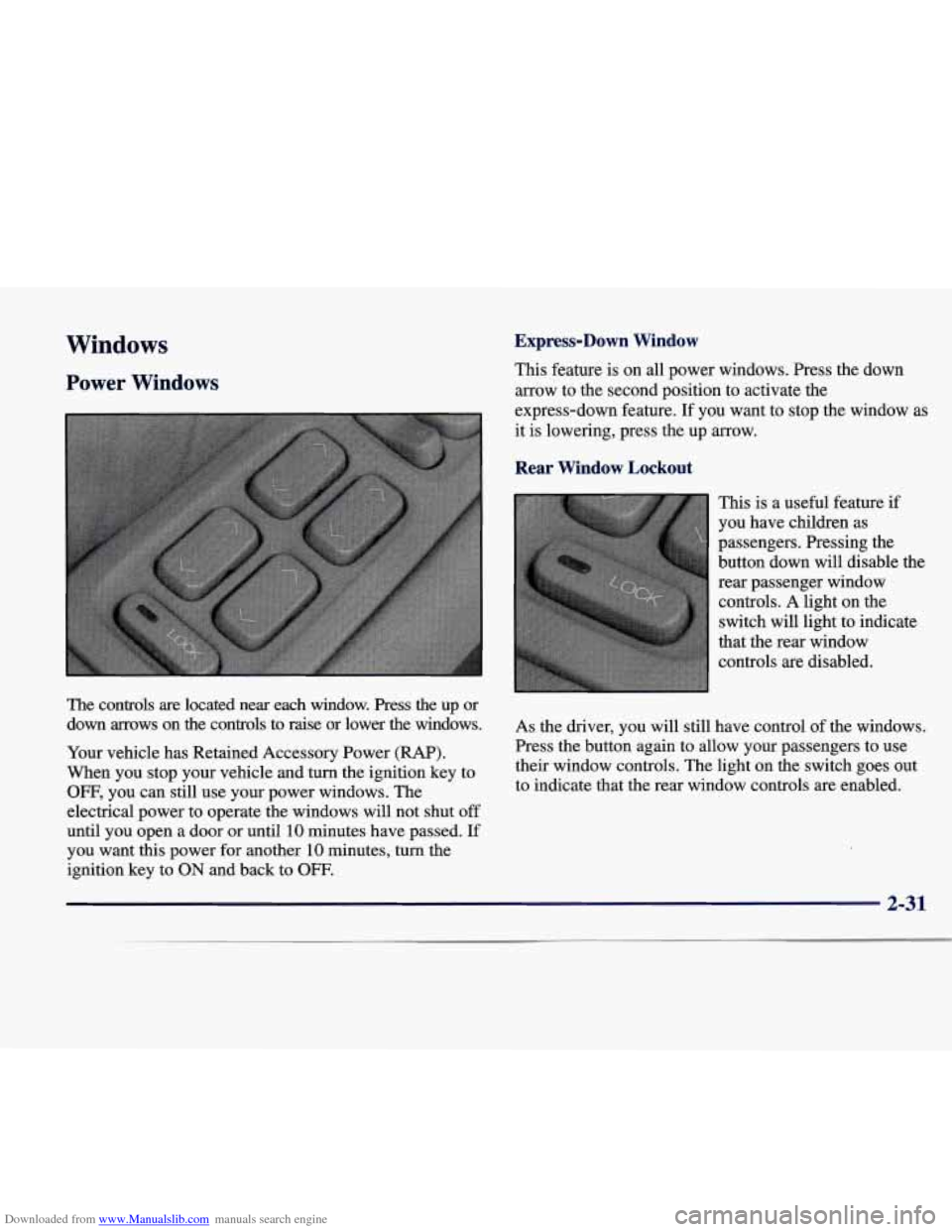
Downloaded from www.Manualslib.com manuals search engine Windows
Power Windows
I
The controls are located near each window. Press the up or down arrows on the controls to raise or lower the windows.
Your vehicle has Retained Accessory Power
(RAP).
When you stop your vehicle and turn the ignition key to
OFF, you can still use your power windows. The
electrical power to operate the windows will not shut
off
until you open a door or until 10 minutes have passed. If
you want this power for another 10 minutes, turn the
ignition key to
ON and back to OFF.
Express-Down Window
This feature is on all power windows. Press the down
arrow
to the second position to activate the
express-down feature. If you want to stop the window as
it is lowering, press the up arrow.
Rear Window Lockout
This is a useful feature if
you have children as
passengers. Pressing the
button down will disable the
rear passenger window controls.
A light on the
switch will light to indicate
that the rear window controls are disabled.
As the driver, you will still have control
of the windows.
Press the button again to allow your passengers to use
their window controls. The light on the switch goes out
to indicate that the rear window controls are enabled.
2-31
Page 93 of 378
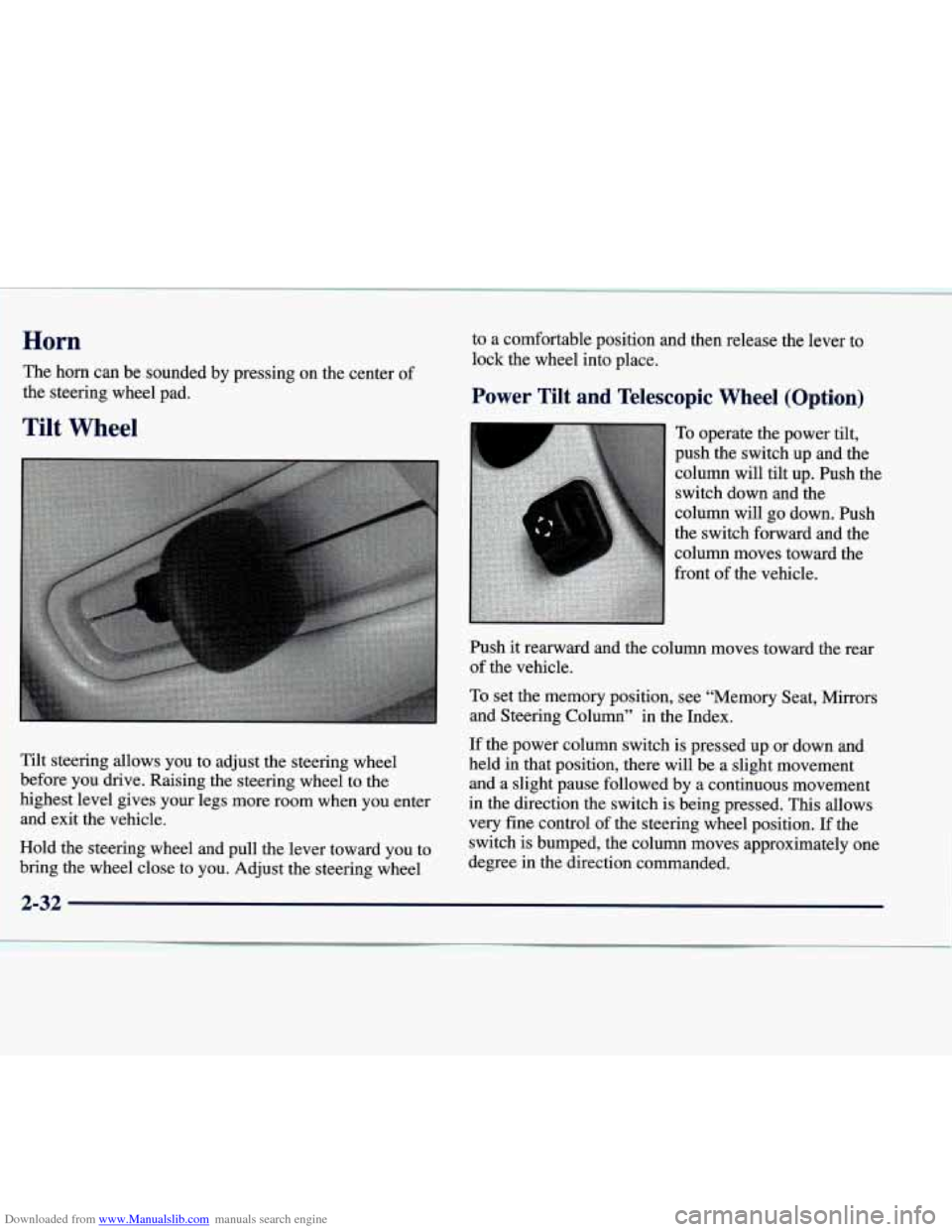
Downloaded from www.Manualslib.com manuals search engine Horn
The horn can be sounded by pressing on the center of
the steering wheel pad. to a comfortable position and then release the lever to
lock the wheel into place.
Power Tilt and Telescopic Wheel (Option)
Tilt Wheel
If the power column switch is pressed up or down and
Tilt steering allows you to adjust the steering wheel held in \
that position, there will be
a slight movement
before you drive. Raising the steering wheel to the and a sli\
ght pause followed by a continuous movement
highest level gives your legs more room when
you enter in the direction the switch is being pressed. This allows
and exit the vehicle. very fine control of the steering wheel position. If the
Hold the steering wheel and pull the lever toward you to switch is bumped, the column moves approximately one
bring the wheel close to you. Adjust the steering wheel degree in the direction commanded.
Page 94 of 378
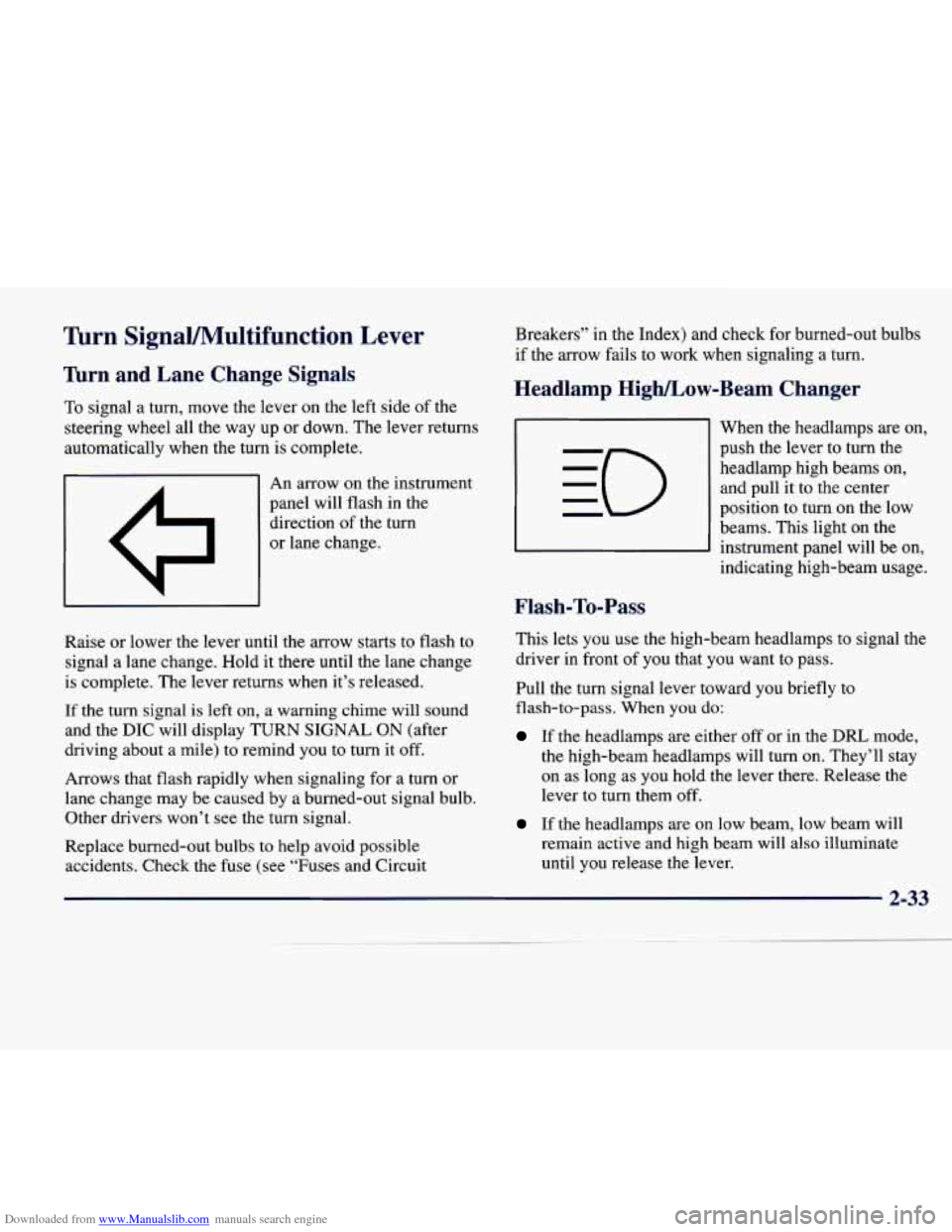
Downloaded from www.Manualslib.com manuals search engine Turn SignaVMultifunction Lever
’hrn and Lane Change Signals
To signal a turn, move the lever on the left side of the
steering wheel all the
way up or down. The lever returns
automatically when the turn is complete.
I A I An arrow on the instrument
panel will flash in the
direction of the turn
or lane change.
Raise or lower the lever until the arrow starts to flash to
signal a lane change. Hold it there until the lane change
is complete. The lever returns when it’s released.
If the turn signal is left
on, a warning chime will sound
and the
DIC will display TURN SIGNAL ON (after
driving about a mile) to remind you to turn it off.
Arrows that flash rapidly when signaling for
a turn or
lane change may be caused by a burned-out signal bulb. Other drivers won’t see the turn signal.
Replace burned-out bulbs
to help avoid possible
accidents. Check the fuse (see “Fuses and Circuit Breakers”
in the Index) and check
for burned-out bulbs
if the arrow fails to work when signaling
a turn.
Headlamp High/Low-Beam Changer
Flash-To-Pass
When the headlamps are on,
push the lever to turn the headlamp high beams on, and pull it to the center
position
to turn on the low
beams. This light on the
instrument panel will be on,
indicating high-beam usage.
This lets
you use the high-beam headlamps to signal the
driver in front
of you that you want to pass.
Pull the turn signal lever toward you briefly to
flash-to-pass. When
you do:
If the headlamps are either off or in the DRL mode,
the high-beam headlamps will turn
on. They’ll stay
on as long as you hold the lever there. Release the
lever to turn them off.
If the headlamps are on low beam, low beam will
remain active and high beam will also illuminate
until you release the lever.
Page 95 of 378

Downloaded from www.Manualslib.com manuals search engine Windshield Wipers
I
You can control the windshield wipers by moving the
lever with the wiper symbol on it. This lever is located
on the right side of your steering column. For
information on wiper activated headlamp operation,
refer to “Wiper-Activated Headlamps”
in the Index.
MIST Pull the lever down once and release it for a
single wipe cycle. For more cycles, hold the lever down
in the MIST position longer.
INTERMITTENT (DELAY): Push the lever up to the
INT position, then turn the band (INT
ADJ), which is
located on the lever, to adjust the delay time. The higher
you
turn the band, the faster the wipers will move.
LO or HI: Push the lever up to LO for steady wiping at
a slow speed. Push the lever higher to
HI for steady
wiping at a high speed.
OFF: Lower the lever to its resting position (OFF) to
turn
off the wipers.
To wash the windshield, press the center button located
at the tip
of the lever.
Be sure to clear ice and snow from the wiper blades
before using them. If they’re frozen to the windshield,
carefully loosen or thaw them.
If the blades do become
damaged, get new blades or blade inserts.
Heavy snow or ice can overload the wiper motor.
A
circuit breaker will stop the motor until it cools. Clear
away snow or
ice to prevent an overload.
2-34
Page 96 of 378
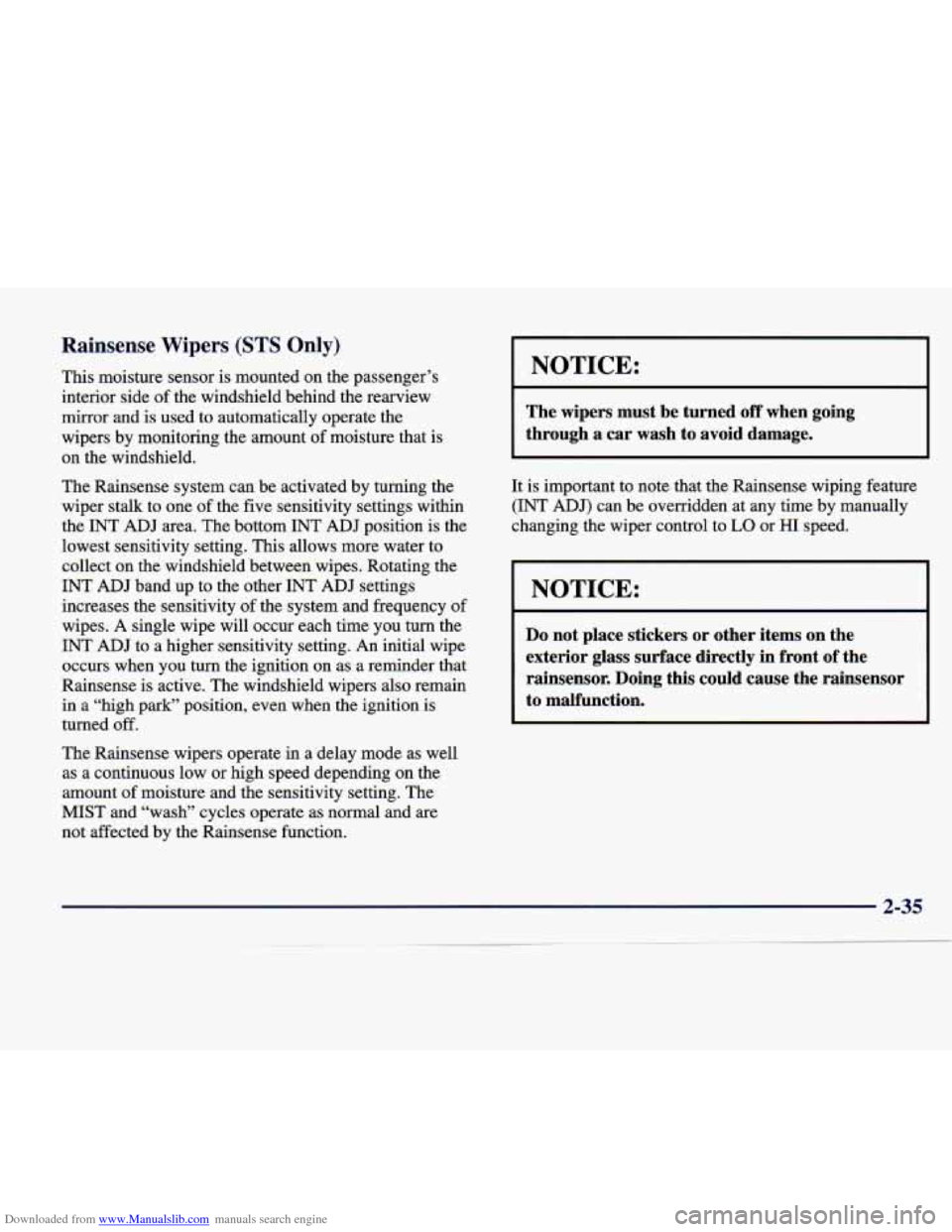
Downloaded from www.Manualslib.com manuals search engine Rainsense Wipers (STS Only)
This moisture sensor is mounted on the passenger’s
interior side
of the windshield behind the rearview
mirror and
is used to automatically operate the
wipers by monitoring the amount
of moisture that is
on the windshield.
The Rainsense system can be activated by turning the
wiper stalk to one of the five sensitivity settings within
the INT
ADJ area. The bottom INT ADJ position is the
lowest sensitivity setting. This
allows more water to
collect on the windshield between wipes. Rotating the
INT
ADJ band up to the other INT ADJ settings
increases the sensitivity
of the system and frequency of
wipes. A single wipe will occur each time you turn the
INT
ADJ to a higher sensitivity setting. An initial wipe
occurs when
you turn the ignition on as a reminder that
Rainsense is active. The windshield wipers also remain
in
a “high park” position, even when the ignition is
turned off.
The Rainsense wipers operate in a delay mode as well
as a continuous low or high speed depending on the
amount of moisture and the sensitivity setting. The
MIST and “wash” cycles operate as normal and are not affected by the Rainsense function.
I NOTICE:
The wipers must be turned off when going
through a car wash
to avoid damage.
It is important to note that the Rainsense wiping feature
(INT
ADJ) can be overridden at any time by manually
changing the wiper control to
LO or HI speed.
NOTICE:
Do not place stickers or other items on the
exterior glass surface directly
in front of the
rainsensor. Doing this could cause the rainsensor
to malfunction.
Page 97 of 378
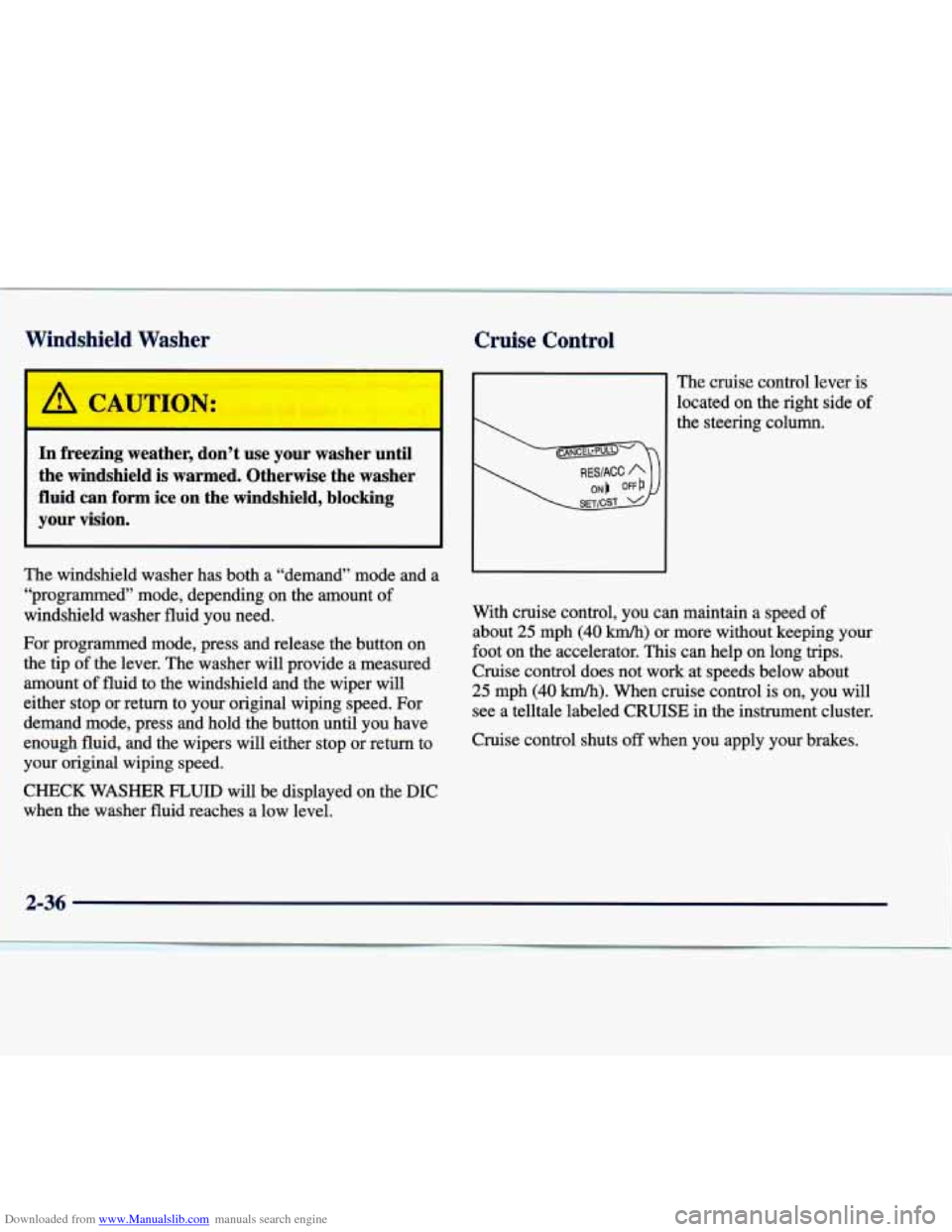
Downloaded from www.Manualslib.com manuals search engine Windshield Washer Cruise Contr-1
In freezing weather, don’t use your washer until
the windshield is warmed. Otherwise the washer
fluid can
form ice on the windshield, blocking
your vision.
The windshield washer has both a “demand” mode and a “programmed” mode, depending on the amount
of
windshield washer fluid you need.
For programmed mode, press and release the button on
the tip
of the lever. The washer will provide a measured
amount
of fluid to the windshield and the wiper will
either stop or return
to your original wiping speed. For
demand mode, press and hold the button until you have
enough fluid, and the wipers will either stop or return to
your original wiping speed.
CHECK
WASHER FLUID will be displayed on the DIC
when the washer fluid reaches a low level.
The cruise control lever is
located
on the right side of
the steering column.
With cruise control, you can maintain a speed
of
about 25 mph (40 km/h) or more without keeping your
foot on the accelerator. This can help on long trips.
Cruise control does not work at speeds below about
25 mph (40 km/h). When cruise control is on, you will
see
a telltale labeled CRUISE in the instrument cluster.
Cruise control shuts
off when you apply your brakes.
2-36
Page 98 of 378
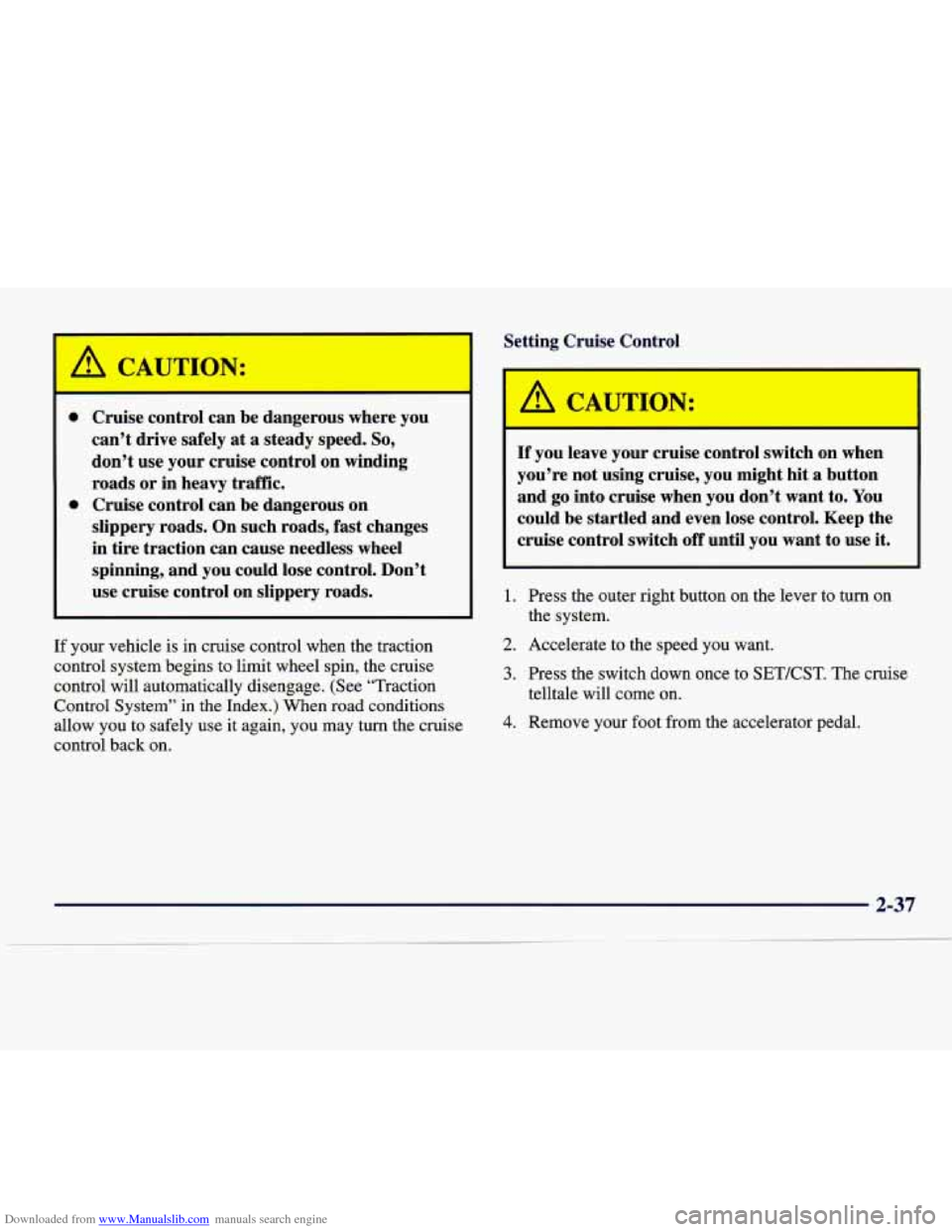
Downloaded from www.Manualslib.com manuals search engine Setting Cruise Control
Cruise control can be dangerous where you
can’t drive safely
at a steady speed. So,
don’t use your cruise control on winding
roads or in heavy traffic.
Cruise control can be dangerous on
slippery roads. On such roads, fast changes
in tire traction can cause needless wheel
spinning, and you could lose control. Don’t
A CAUTION:
If you leave your cruise control switch on when
you’re not using cruise, you might hit
a button
and go into cruise when you don’t want to. You
could be startled and even lose control. Keep the
cruise control switch
off until you want to use it.
use cruise control on slippery roads.
I l.
I I
I I
If your vehicle is in cruise control when the traction
control system begins to limit wheel spin, the cruise
control will automatically disengage. (See “Traction
Control System” in the Index.) When road conditions allow you to safely use it again, you may turn the cruise
control back on. 2.
3.
4.
Press the outer right button on the lever to turn on
the system.
Accelerate to the speed you want.
Press the switch down once to SETKST. The cruise
telltale will come on.
Remove your foot from the accelerator Pedal.
Page 99 of 378
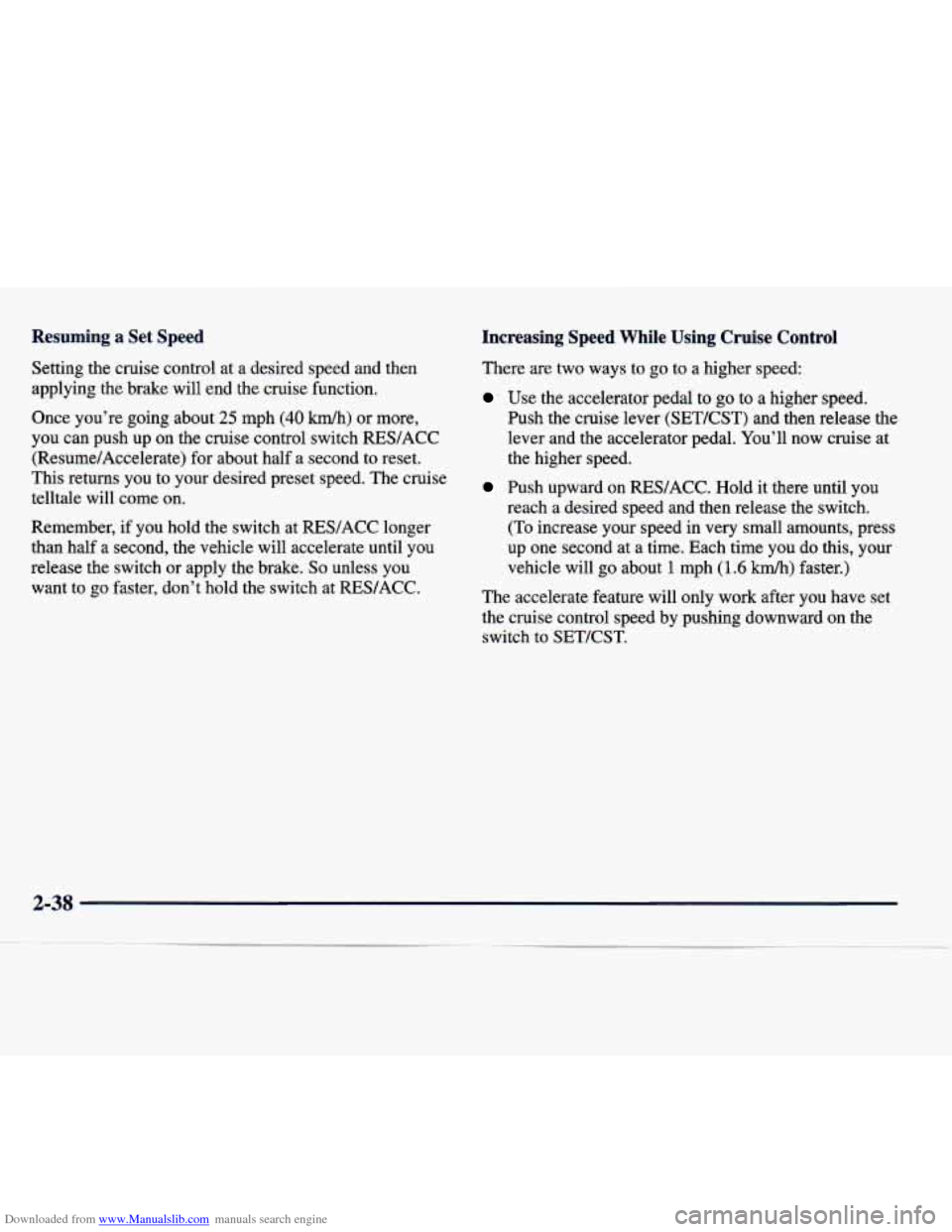
Downloaded from www.Manualslib.com manuals search engine Resuming a Set Speed
Setting the cruise control at a desired speed and then
applying the brake will end the cruise function.
Once you’re going about
25 mph (40 km/h) or more,
you can push up
on the cruise control switch RES/ACC
(Resume/Accelerate) for about half a second to reset.
This returns you to your desired preset speed. The cruise
telltale will come on.
Remember,
if you hold the switch at RES/ACC longer
than half
a second, the vehicle will accelerate until you
release the switch or apply the brake.
So unless you
want to
go faster, don’t hold the switch at RES/ACC.
Increasing Speed While Using Cruise Control
There are two ways to go to a higher speed:
Use the accelerator pedal to go to a higher speed.
Push the cruise lever (SETKST) and then release the
lever and the accelerator pedal. You’ll now cruise at
the higher speed.
Push upward on RES/ACC. Hold it there until you
reach a desired speed and then release the switch.
(To increase your speed in very small amounts, press
up one second at a time. Each time you
do this, your
vehicle will
go about 1 mph (1.6 km/h) faster.)
The accelerate feature will only work after you have set
the cruise control speed by pushing downward on the
switch to SET/CST.
2-38
Page 100 of 378
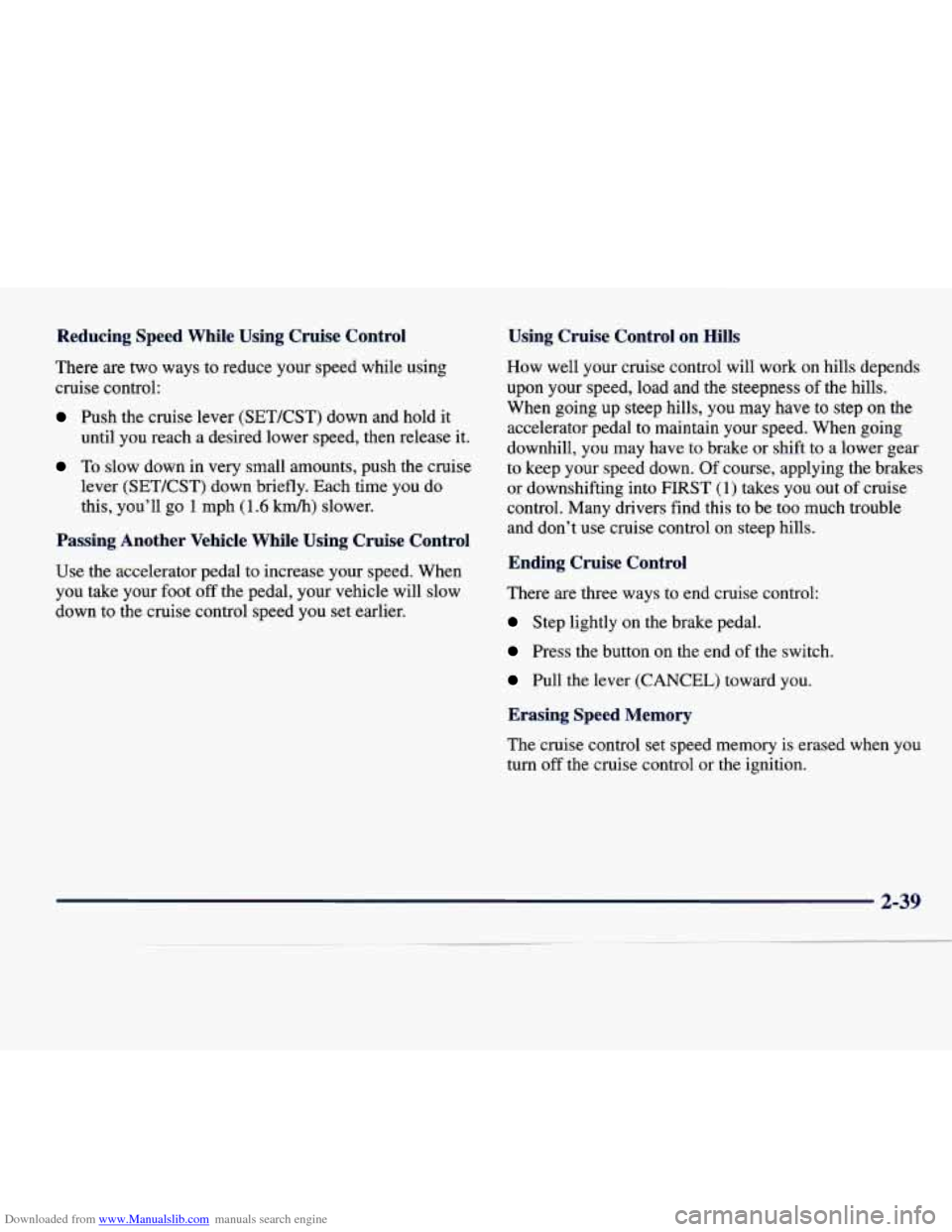
Downloaded from www.Manualslib.com manuals search engine Reducing Speed While Using Cruise Control
There are two ways to reduce your speed while using
cruise control:
Push the cruise lever (SETKST) down and hold it
until you reach a desired lower speed, then release it.
To slow down in very small amounts, push the cruise
lever (SETKST) down briefly. Each time
you do
this, you’ll
go 1 mph (1.6 km/h) slower.
Passing Another Vehicle While Using Cruise Control
Use the accelerator pedal to increase your speed. When
you take your foot
off the pedal, your vehicle will slow
down to the cruise control speed you set earlier.
Using Cruise Control on Hills
How well your cruise control will work on hills depends
upon your speed, load and the steepness
of the hills.
When going up steep hills,
you may have to step on the
accelerator pedal to maintain your speed. When going
downhill, you may have
to brake or shift to a lower gear
to keep your speed down. Of course, applying the brakes
or downshifting into FIRST
(1) takes you out of cruise
control. Many drivers find this to be too much trouble and don’t use cruise control on steep hills.
Ending Cruise Control
There are three ways to end cruise control:
Step lightly on the brake pedal.
Press the button on the end of the switch.
Pull the lever (CANCEL) toward you.
Erasing Speed Memory
The cruise control set speed memory is erased when you
turn off the cruise control or the ignition.